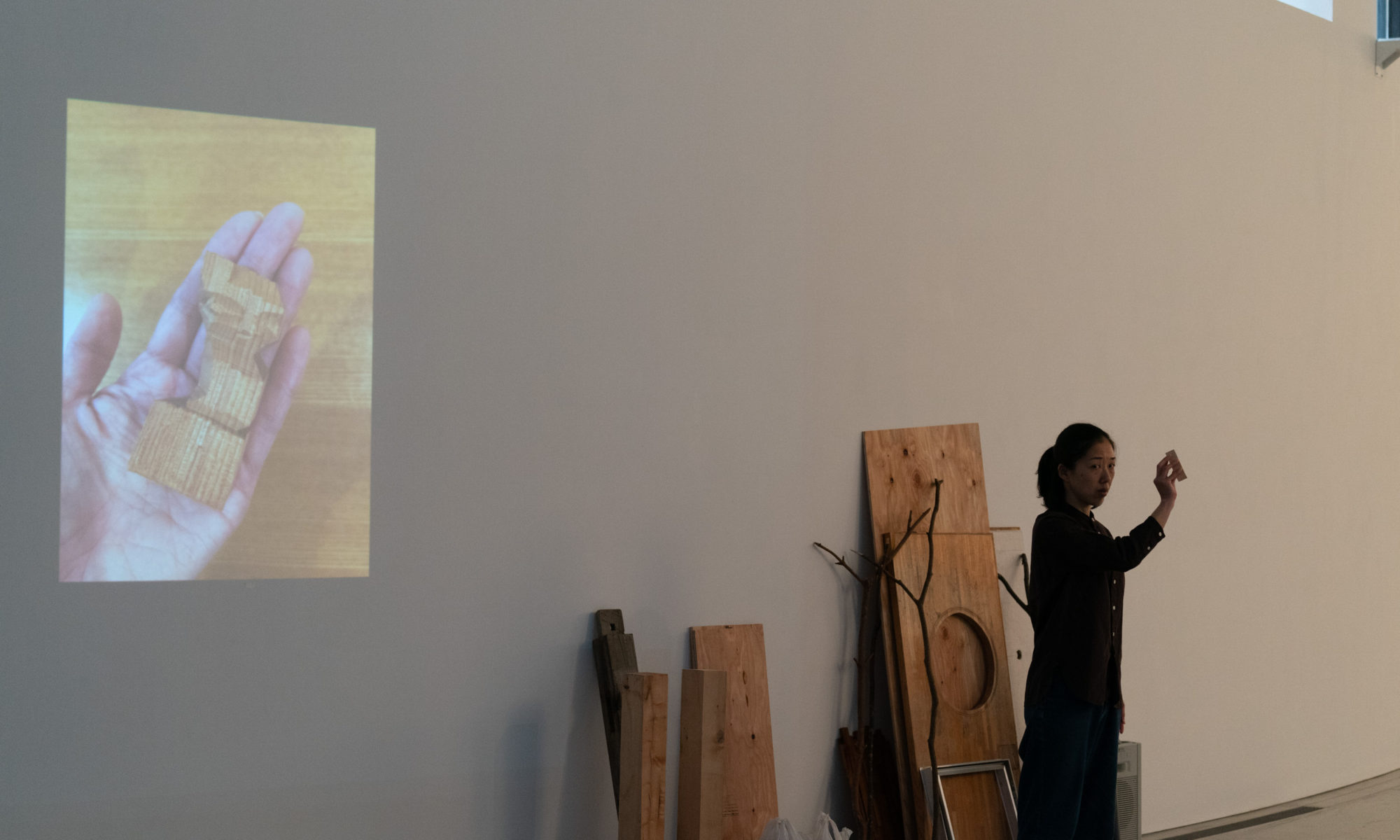ダンスの存在論―自問自答とひらかれの射程
慶野結香
神村恵はコンテンポラリーダンスを活動の基盤とし、他のダンサーや観客との協働はもちろん、様々な美術家たちとのコラボレーション、美術館やギャラリーなど劇場以外の空間でのパフォーマンスを多く手がけてきたダンサー・振付家である。近年は「ダンス作戦会議」(1)で演劇も行うなど、その活動は多岐に渡る。2008-2011年にかけてACACで行われた、イギリスの振付家ショーネッド・ヒューズの「青森プロジェクト」にダンサーとして参加していたため、ACACの環境を知っていて、青森の気候や伝統文化にも触れたことがあった神村は今回、じっくりと自身の作品に取り組むためレジデンスに参加したいと思ったという。
《彼女は30分前にはここにいた。》は、2019年にblanClassで初演されたソロのダンス作品である。会場に大きな窓があったことから部屋に射し込む自然光を取り込むことにし、リニアで絶対的な時の流れが空間へ反映されやすい日没前後の上演を選んだ。環境の変化と共にダンサーの行為の痕跡が蓄積され展開していくのだが、画家のドローイングや思想家のテキストが引用されることで、時間軸や自己―他者といった関係は複雑な様相を呈する。ある意味、自閉的でありながらもひらかれている本作のあり方は「小屋」を彷彿とさせる。この基本的なアイデアは青森でも引き継がれ、ACACギャラリーAの窓が西日を映し、夜へと急ぐ黄昏時の約1時間を公演として観客にひらくこととなった。
神村は約2ヶ月の滞在期間中「小屋」についてリサーチを行い、青森県内を飛び回った。首都圏に比べれば田畑も多く、土地も広い青森には、農作業で使用する器具を収納するなど何らかの用途に特化しながら、その主によってアレンジ、転用された個性豊かな小屋が多数存在する。神村は物によって空間における身体の動きが規定≒振付されていることへの関心から、小屋の設えや物の配置が身体の延長としていかに位置づけられるのかリサーチを通して見極めようとした。これに加え、青森、秋田、岩手にまたがる北東北の縄文遺跡にも足を延ばし、集落や祭祀場など人の営みの根源を追い求めた。彼女のフィールドワークは、人類学のように他者や現象を具体的に考察するためのものではない。観察から得た印象や目に留まった動きが、神村の主観や身体感覚に落とし込まれ、ダンスの動きに影響を与えるのだ。さらに今回のリサーチによって、作品の中にある程度具体性をもったナラティブが出現したことは特筆すべきであろう。
1. 青森の地に根付き、膨大な数の彫刻作品を遺した鈴木正治(1919-2008)の作品と彼のアトリエを見た神村は、鈴木が木や石といった素材が自然としてあった時の姿を損なわないよう彫刻したことを看取し、青森県立郷土館所蔵の《誕生》の中から、作家の手の痕跡が分かる小品を選んで、身体でなぞっていく。やがて神村の身体に収まりきらなくなった形の力は、四角く画一的なアトリエの中に吸い込まれ、構造物を内破し解体する。
2. マタギの炭焼小屋など山間部に見られる木のマッカ(股)を用いて、簡易的な小屋を組み、今回のリサーチで小屋について考えたことを述べる。また、小屋における自由の発露と対照的ながら近似な存在として牢屋や監獄をあげ、ドストエフスキー『死の家の記録』(1862)の一節を音読し、居場所と想像力の関係性を問う。
3. 日没へと向かう中、リノリウムのマットや廃材で、地面から盛り上がる小屋的構造物を形成する。これは御所野遺跡(岩手県)に見られる縄文時代の土屋根建物を彷彿とさせる。やがて懐中電灯の明かりで自らを、次に周囲を照らしながら振り回され、これまでに作ってきた小屋の数々を壊し闇に消える。
ワークインプログレス公演で既に上記の筋は完成していたが、本公演で神村は、2. ドストエフスキーの朗読を行った後、当初は小屋における自由を描くように「Fly Me to the Moon」をCDラジカセでかけ、音を空間に響かせながら自己陶酔のごとく踊っていたシーンに替え、小屋を成立させている想像力から派生して、想像力と現実の関係をダンス論に読み替えた。本当は目に見えないはずの想像力という内面をダンスという表現/外面として提示しているのではないか、観客もそれをダンスの中に見たいと思っているのではないかという自問自答である。問いながら、小屋の屋根だったビニール布は旗となり、やがて制御できなくなった想像力に振り回され力尽きる。
神村によるそれぞれの小屋へのアプローチに共通点を見出そうとするならば、それはあるきっかけと理由によって建てられた小屋は当事者の身体と不可分であり、小屋という装置は内外の、もしくは容易に分かち難い空間を発生させる身体的なものであること。踊る身体もまた、言葉と深く結びつきながら思考を伴うことで、空間を思考装置と化すことが出来ること。しかし、思想や想像力といった形を成す根本にある見えない力の作用によって、物としての小屋は瓦解してしまう。壊れることを死と捉えるならば、物体としての身体もいつか終わりを迎えざるを得ない。だが、ある生によって残された物が示す痕跡は、他者の身体によって解釈を与えられつつ、再生されることが可能なのではないか…
青森では、公演以外にも様々な実験的活動を行った神村。自身の手脚など断片的な身体が建築や風景と戯れる様子を数秒で捉えた映像作品。南部地方の盆踊り「ナニャドヤラ」をスコア(譜面)化し、複雑な動きを頭と身体―経験的な理解との往還によってマスターしようとするワークショップ。これらのアプローチが、自らの痕跡をいかに記録し、別の時空間や身体で再生する興味や欲望によるのではないかと言えば、邪推が過ぎるだろうか。
「彼女は30分前にはここにいた。」というタイトルは、ヴィトゲンシュタインのアフォリズムの中から援用されたものだという。ノルウェーの小屋にこもり、1913年から『論理哲学論考』(1921)を、1936年の滞在で『哲学探究』(1953)を書き始めた哲学者は、自問自答を繰り返しながら、問いを他者にひらき続ける。神村の自問自答もまた、一定の時空間や他者を身体―空間に取り入れつつ、別の他者にひらかれる。そしてその営みは踊る/踊られる限り、生じては消えていく。
(1)「ダンス作戦会議」は、ダンスの当事者が流動的に集まる場として、2018年10月に発足した。集会としてのダンス公演や、ダンサーの身体による演劇などダンスをひらくための多様な実践を行っている。
————–
Ontology of Dance—Wondering to oneself and the range of being open
KEINO Yuka
KAMIMURA Megumi, dancer and choreographer, bases her activities on contempo-rary dance, and she has collaborated with not only other dancers and audiences but also various artists, and she has often performed in a space other than theaters like museums and galleries. Her activities cover a wide range including the play that she performed at Dance Strategy Meeting in recent years. As Kamimura participated as a dancer in “Aomori Project” put together by choreographer Sioned HUWS from U.K. held at ACAC in 2008 through 2011, she knew the environment surrounding ACAC and was aware of the climate in Aomori and local traditional culture. She said that she wanted to participate in the residence program to concentrate carefully on the work.
Her solo dance piece She was here 30 minutes ago. was performed for the first time at blanClass in 2019. As there were big windows at the place, she decided to let natural light come into the room, and she chose to perform around sunset when a linear and ab-solute flow of time can be easily reflected in space. In the performance, changes in the environment and the traces of the dancer’s actions were accumulated and developed. While an artist’s drawing and a philosopher’s text were quoted, time axes and relation-ships such as self and others assume a complex aspect. The situation of how this work is being autistic while being open reminds us of a “shed.” This basic idea was carried on to Aomori, and her performance was open to the public for about an hour when the window at Gallery A reflected twilight rushing to night.
Kamimura did research on “sheds” for about two months in her residence program and she traveled around Aomori Prefecture. Compared with urban districts, Aomori has vast open land with many fields and rice paddies. There are many unique sheds specific to such uses as storing tools for farming and are arranged or changed for their purposes by shed owners. As Kamimura was interested in how the body movements in space are regu-lated (≈ choreographed) by things, she tried to see, through her research, how the ar-rangement in the sheds and positions of things could be interpreted as the extension of the body. Moreover, she visited the Jomon remains extending over Aomori, Akita and Iwate to explore the origin of human activities including settlements and worship sites. Her fieldwork is not to study others and phenomena in detail as in Anthropology. Im-pressions that she received from her observation and the movements that she paid atten-tion to are taken in through her subjective views as well as physical senses to influence her dance movements. It is worth noting that her research this time added narrative in her work with some specificity.
1. After seeing works and a studio of SUZUKI Masaharu (1919—2008) who lived in Aomori and left a vast number of sculptures, Kamimura recognized that he made sculptures trying not to ruin how the materials, such as wood and stones, were in nature, and she selected a small work that bears the art-ist’s hand marks from his Birth collected by Aomori Prefectural Museum and traced after it with her body. The power of the form that did not fall into her body was sucked into the square and uniform studio, destroyed and took the construction apart from inside.
2. She constructed a simple shed using a tree crotch that is seen in mountainous areas such as a charcoal burner’s lodge of Matagi (traditional winter hunters in Tohoku region), and she talked about what she felt about sheds in this re-search. She also referred to prisons and jails in contrast to free expressions in sheds, read aloud a passage from DOSTOYEVSKY’s The House of the Dead (1862) and questioned about a relationship between where someone stayed and imagination.
3. Towards evening, she made a shed-like structure that protruded from the ground with linoleum mats and wood waste. It reminded people of a soil-roofed construction from the Goshono Jomon site. Later she lit herself with a flashlight and swung it (or was she swung instead?) while lighting up the au-dience. She then destroyed the sheds that she had built and vanished in the dark.
The above scenario was already completed in her work-in-progress performance. Origi-nally, after she was finished with reading Dostoyevsky, she played the CD Fly Me to the Moon as if to illustrate freedom in a shed and indulged in dancing as the sound was echoing in the space. She changed the scene, and this time she read about dance theory out of a relationship between imagination and reality, deriving from imagination that made sheds exist. Here she was wondering to herself that she was presenting the inner phase called imagination as dance, which was the expression/the outer phase, and also that the audience wanted to see that in dance. While she asked that herself, the vinyl cloth that was a shed’s roof became a flag and she was brandished by uncontrollable imagina-tion to use up all her strength.
If I try to find something in common with Kamimura’s approach to each shed, I could say that the shed built for some cause and reason is inseparable from the owner’s body and the device called shed is physical in that it generates inside and outside spaces that are difficult to be separated. The dancing body also can turn space into a thinking device while being deeply connected with words and involving thoughts. By the effect of under-lying invisible power at the root of such a form such as thought and imagination, howev-er, the shed as a thing will collapse. If you think of breaking down as death, the body as a physical matter comes to an end. Traces left by some living being, however, could be re-produced if it were given an interpretation by the other’s body, couldn’t they?
Kamimura conducted various experimental activities other than the performances in Aomori. She made videos captured in a few seconds in which her fragmental body parts such as hands and feet had fun with architecture and scenery. She also held workshops to make bon-festival dance “Nanyadoyara” of the Nanbu region into scores so that people could master the complex movements through going back and forth between head and body and empirical understanding. If I say that these approaches are based on how she records her own traces, her interests and desire to reproduce them with another body in other space/time, would it be a groundless reasoning? Her work She was here 30 minutes ago. was quoted from Ludwig WITTGENSTEIN’s aphorism, she says. Staying in a shed in Norway, the philosopher started to write Tractatus Logico-Philosophicus (1921) in 1913, and Philosophical Investigations (1953) during his stay in 1936. While trying to find an answer to his questions, he kept asking questions to others. Kamimura’s own questions to herself are also opened to others while incorporating certain time/space and others into body-space. Such activity will occur and disappear as long as she dances and it is danced by others.
(Translated by NISHIZAWA Miki)
Photo: Kuniya OYAMADA

